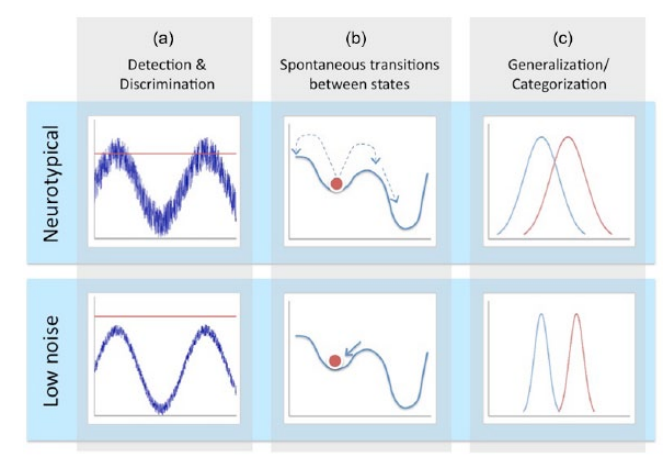Low Endogenous Neural Noise in Autism
Neurons in the human brain process information as changes in electrical activity. Many of these changes encode important signals, controlling how we think, move and perceive the world around us. Many other changes, however, seem to be random, encoding no information. These random fluctuations, often called ‘neural noise’, reduce our ability to detect faint patterns in a picture or to hear faint sounds. However, neural noise may also enhance some important brain functions. First, noise likely causes the brain to shift from thinking about, or looking at, one thing to thinking about or looking at other. While this can limit our ability to focus on a task, it prevents us getting stuck in one way of thinking or on one topic. Second, neural noise would be expected to increase how similar objects and situations seem to one another. This may reduce our ability to tell the difference between objects but also causes the brain to use what it has learned about one object or situation in many other similar cases. If these ideas about the effects of neural noise are correct, people whose brains have less neural noise than usual would be expected to see faint patterns or small objects very well. Their attention would tend to remain focused on one topic or way of thinking, and while they may learn quickly about a particular object in one in situation, they may not automatically apply that learning to slightly different objects or different situations. We suggest that the brains of children and adults with autism spectrum disorder (ASD) may have less neural noise than typical brains, bringing some benefits to those people, but also some difficulties.
We investigated these ideas in a categorisation study. The ability to categorise objects and experiences is important for allowing us to process and respond to new information efficiently. It is also hugely important during development, for example when babies learn to understand different facial expressions. In order to categorise new information we must apply what we have learnt during previous similar experiences. This is something that children and adults with autism sometimes find difficult and, while it may be helpful in situations requiring very good attention to detail, it can cause problems in applying what is learnt in one context (such as at school) to a different situation (such as at home). It is possible that these generalisation processes require a relatively high level of neural noise to be present in the brain and so if levels of neural noise are lower information is categorised differently. We are currently investigating whether categorisation processes do differ in individuals with ASD and, if so, whether this could be the result of them having lower levels of neural noise than in the neurotypical brain.
Find out more by reading the paper, or click on the infographic!

